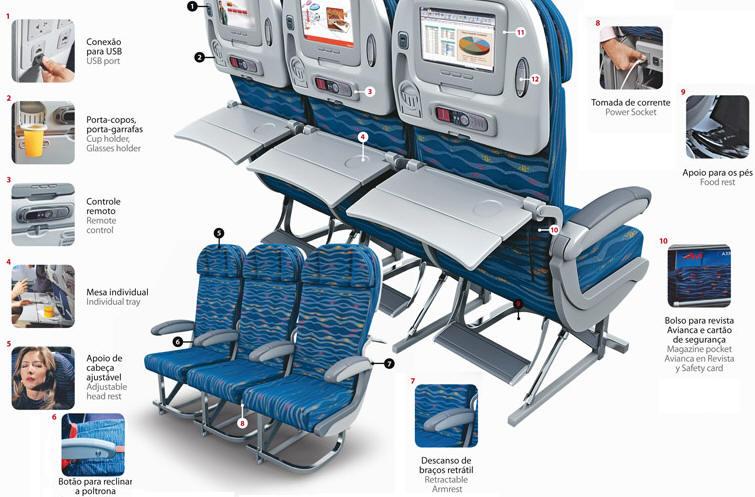 |
Avianca (Brasil) Fleet
> Fleet/Year:
| E |
|
> Historical Fleet:
|
Airbus A330-200 |
 In
2017 Avianca Brazil finally decided to take out the plan to launch
flights to the USA with Airbus A330-200. Four A330s have been available
to the company since mid-2015 and have been stocked expecting the
company's decision. The first A330-200 arrived in Brazil in March 2017
and began operating in April on São Paulo - Fortaleza route. Another two
units arrived few weeks after to operate the São Paulo - Miami and São
Paulo - Santiago routes. In
2017 Avianca Brazil finally decided to take out the plan to launch
flights to the USA with Airbus A330-200. Four A330s have been available
to the company since mid-2015 and have been stocked expecting the
company's decision. The first A330-200 arrived in Brazil in March 2017
and began operating in April on São Paulo - Fortaleza route. Another two
units arrived few weeks after to operate the São Paulo - Miami and São
Paulo - Santiago routes.Business Class seats are arranged in 1-2-1 configuration, with dividers, 180º recline, remote control, auxiliary lighting, plugs, USB connection and adjustable head rest. Passengers will also enjoy an on-demand entertainment system with a wide variety of movies, series and games on 15-inch touch screens and a kit of amenities. Economy Class is configured with 2-4-2 seats, individual 9-inch touchscreen displays, remote control, power outlet, USB port, and adjustable head and foot rest. The A330s are also equipped with LED lighting and Avianca aims to equip aircraft with wi-fi.
|
|
|
Airbus A320neo |
 Avianca
Brasil was the second airline in South America to receive the A320neo
and the first in the Americas to operate it with LEAP-1A CFM
International engines. The aircraft promises a fuel economy of about 15%
compared to the previous model. Avianca Brasil has selected the A320neo
as the substitute for all current models of the fleet and intends to
operate it even at Rio - SP route. Avianca
Brasil was the second airline in South America to receive the A320neo
and the first in the Americas to operate it with LEAP-1A CFM
International engines. The aircraft promises a fuel economy of about 15%
compared to the previous model. Avianca Brasil has selected the A320neo
as the substitute for all current models of the fleet and intends to
operate it even at Rio - SP route.
|
|
|
Airbus A330-200F |
|
In 2014 Avianca Brazil received its first Airbus A330-200F and became
the first airline in Brazil to operate the A330 cargo version. This was
also the first Avianca Brazil wide-body and the first aircraft with the
new paint shame. |
|
|
Airbus A320 |
|
In October 2011 Avianca's president announced four new A320. The aircrafts were already part of Avianca's group order which includes A320 Family and A330-200. Avianca's A320 complement the A318 and A319 on high demand routes. Like A319, A320 have individual entertainment system and more space between seats, making the A320 more comfortable in South America. In September 2013 Avianca received its first A320 equipped with Sharklet wingtip.
Length: 37.57 m
|
|
|
|
Airbus A319 |
|
A319 marked a new era in Oceanair's history. In April 26, 2010
OceanAir was renamed Avianca (Brazil). For over two years was rumor it
could happen because Avianca and OceanAir are in the same group (Synergy).
The first clue occurred when a Oceanair's Fokker 100 appeared with
Avianca's tail. But the confirmation came with the first Airbus A319 in
full Avianca colors.
Length: 33.84 m
|
|
|
Fokker F-100 (MK 28) |
|
In 2005 OceanAir began to receive its first jets, Fokker 100 (former American Airlines), but the airline renamed it as "MK28" because of Fokker 100 bad reputation in Brazil, after several accidents with Tam. The first flight took off on January 9, 2006 on São Paulo - Rio de Janeiro - Maceio - Fortaleza - Juazeiro do Norte route. With Fokker 100, Oceanair expanded its network, launched its new paint shame (equal to Avianca) and changed their plans, abandoned regional routes. The airline operate 16 MK28 simultaneously, but suffered losses and reduced its fleet to 14 MK28. On April 26, 2010 OceanAir was renamed Avianca Brazil and began to standardize its fleet with Airbus aircraft. All Fokker 100 should be replaced by A320. Length: 25.25 m
|
|
|
Boeing 737 / 757 /
767 |
|
In August 2007 Oceanair announced the acquisition of one Boeing
757-200 and one 767-300. It was the first Boeing 757 with winglets in
Brazil. The B767 began international flights to Mexico City. When BRA ceased
in November 2007, OceanAir took its routes and incorporated two
additional Boeing 767-300 and three Boeing 737-300. OceanAir even
announced flights to Luanda and Lagos. But with bad occupations on
flights to Mexico (less than 30%) and losses, Oceanair decided to
restructure the fleet and routes, thus operate only
Fokker 100. |
|
|
Fokker F-50 |
|
Fokker 50 was the second aircraft type operated by OceanAir. In 2003 it
received the two first to complement the EMB-120. In 2004
received the third. In 2005 Oceanair were retired.
|
|
|
Embraer EMB-120 |
||||||||||||||||
|
OceanAir began operations as a regional airline in 2002. The first
aircraft were three Embraer EMB-120 ex-Rio Sul (Varig's subsidiary).
OceanAir began to operate between Rio de Janeiro, Macaé and Campos. Wingspan: 19.78 m Height: 6.35 m Engines: 2x Pratt & Whitney Canada PW118 turboprops Crusing Speed: 582 km/h Passengers: 30
|






































